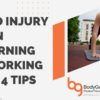By: Dr. Lindsay Weston, PT, DPT
Much attention has been given to activating the abdominal core, and rightly so; activating the abdominal core is essential for the body to have control over our movement. Without activating the abdominal core, the body would move with less control, similar to the fabric inflatable wind dancers used to attract the attention of passerby’s outside of businesses.
The foot core is equally essential for movement. The foot intrinsic musculature, which make up the foot core, create the arch of the foot. The foot intrinsics enable the foot to adapt to different activities and situations. When walking and running, the foot must be rigid when first contacting the ground and during push off, however, the foot should also be mobile when the middle of the foot is in contact with the ground1. For example, when hiking on uneven ground, the typical movement strategy is to first contact the ground at the middle of the foot instead of walking from heel to toe. Babies who are first learning to walk and who have not yet developed an arch also contact the ground at the middle of the foot. This enables the foot to adapt to uneven terrain and can help with balance.
Prior rehabilitation programs have emphasized treating foot extrinsic musculature, which is a larger group of foot muscles, while the foot intrinsics are ignored. The foot core intrinsic muscles are essential to efficient movement and create the spring-like characteristics of the arch where the muscles store elastic energy with each heel strike to be used during push off, thus giving a “spring” to your step. When walking, the arch naturally shortens and lengthens to adapt to the body’s needs.
What is the foot core?


The foot core is made up of four layers of local arch stabilizing muscles2. With each step, the four layers of foot intrinsic muscles control the amount and speed of arch shortening and lengthening. When the foot intrinsics are not activating properly, it can result in poor foot positioning, which then creates pain and may increase the risk for injury1. Common injuries that may be influenced by poor foot intrinsic activation include plantar fasciitis, shin splints, and chronic ankle sprains.
How are the foot intrinsics treated in physical therapy?
At Body Gears Physical Therapy, we take a multidimensional approach to rehabilitating foot and ankle issues. Our approach using Functional Manual Therapy® corrects the mechanical dysfunctions of bones, tissues, and other structures so the foot can physically achieve the optimal alignment for intrinsic muscle activation. The muscles are then retrained to support the new foot alignment with neuromuscular re-education and exercises. These changes are then integrated into activities that were previously painful or challenging.


An exercise used at Body Gears Physical Therapy for foot intrinsic strengthening is called “foot doming” where the patient raises the arch and then maintains the raised position against resistance or exercises. This helps to engage the foot core so that it can more optimally support the arch.
References
- Muscles of the Foot – Dorsal – Plantar – TeachMeAnatomy. Teachmeanatomyinfo. 2016. Available at: http://teachmeanatomy.info/lower-limb/muscles/foot/. Accessed June 13, 2016.
- McKeon P, Hertel J, Bramble D, Davis I. The foot core system: a new paradigm for understanding intrinsic foot muscle function. British Journal of Sports Medicine. 2014;49(5):290-290. doi:10.1136/bjsports-2013-092690.






